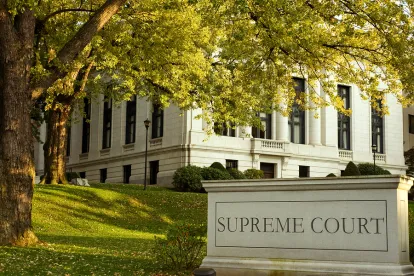The Court finds that ERISA preempts the state law “All Payer” data requirement.
In a 6–2 decision issued on March 1, the US Supreme Court affirmed a US Court of Appeals for the Second Circuit decision holding that the Employee Retirement Income Security Act of 1974, as amended (ERISA), preempts Vermont’s data reporting requirements, as applied to self-insured group medical plans (and their plan administrators) in Gobeille v. Liberty Mutual Insurance Co. (No. 14-181, March 1, 2016). The majority opinion, written by Justice Anthony Kennedy, concludes that “[t]he state statute imposes duties that are inconsistent with the central design of ERISA, which is to provide a single uniform national scheme for the administration of ERISA plans without interference from laws of the several States[,] even when those laws, to a large extent, impose parallel requirements.”
Background
The case involves a Vermont statute—similar to the laws in approximately 17 states—that requires public and private entities that provide healthcare services to report data to a state agency. The data so accumulated is compiled into a database that shows healthcare use, costs, and resources in Vermont, as well as data about healthcare services provided to Vermont residents in other states. The challenged statute did not impose any substantive requirements on the healthcare plans subject to the reporting requirements but purported to apply to both insured and self-insured plans and to the healthcare companies that administer those plans. The district court that reviewed the matter found that the Vermont statute was not preempted by ERISA as applied to self-insured plans, but the Second Circuit reversed the district court, holding that the Vermont statute imposed a material burden on self-insured plans. The Supreme Court affirmed the Second Circuit’s decision, barring Vermont from applying the statute’s requirements to self-insured plans.
ERISA’s preemption provision has been described by the Supreme Court as one of the broadest in any federal law. ERISA supersedes “any and all state laws as they may now or hereafter relate to” an ERISA plan.[1] This extremely broad preemption standard has been the basis for striking down state regulations in a number of Supreme Court cases, especially those where the challenged state regulation applied to a “core” ERISA function, such as plan administration. The majority in Gobeille quickly concluded that “reporting, disclosure, and recordkeeping are central to, and an essential part of, the uniform system of plan administration contemplated by ERISA” and that those “requirements are integral parts of ERISA.” In view of that rationale, the majority held that “Vermont’s reporting regime, which compels plans to report detailed information about claims and plan members, both intrudes upon ‘a central matter of plan administration’ and ‘interferes with nationally uniform plan administration,’” thus triggering preemption.
The majority was not impressed by Vermont’s argument that its reporting requirements do not result in “economic burdens” to the plan. Instead, the Court emphasized that the requirement “regulates a central aspect of plan administration and, if the scheme is not pre-empted, plans will face the possibility of a body of disuniform state reporting laws and, even if uniform, the necessity to accommodate multiple governmental agencies.” The majority also dismissed Vermont’s argument that preemption is not implicated because the Vermont regulatory requirements have different goals than reflected in the substantive provisions of ERISA—that the Vermont program “has nothing to do with the financial solvency of plans or the prudent behavior of fiduciaries.” That purported difference in purpose did not make a difference to the majority; instead, the Vermont provision was preempted as “a direct regulation of a fundamental ERISA function.” The majority then distinguished prior decisions that permit the application of state hospital taxes to hospitals owned by ERISA plans, even though the challenged state taxes “necessitate[d] incidental reporting by ERISA plans.” However, the majority found that, unlike the prior-considered tax laws, the Vermont provision touched on “a fundamental area of ERISA regulation” and, as a result, “counters the federal purpose.”
The Justices’ Differing Opinions
The concurring and dissenting opinions highlight the divisions among the justices regarding the scope of ERISA preemption. Justice Clarence Thomas’s concurrence agrees that the majority decision faithfully applies Supreme Court jurisprudence on ERISA preemption but questions whether ERISA’s preemption provision was even a valid exercise of congressional power in the first place. Justice Thomas’s concern is that perhaps Congress cast the scope of ERISA preemption too broadly in the first place and has the provision touch on arrangements such that it impinges on traditional state areas of regulation that Congress cannot permissibly regulate under the Commerce Clause.
Justice Stephen Breyer’s concurrence highlights that the secretary of labor has the authority to impose additional reporting requirements that would accomplish Vermont’s goals, or even perhaps could delegate such authority to the states, which suggests that he might have reached a different conclusion if there were not such a ready regulatory workaround. Although the US Department of Labor (DOL) has plenty on its plate right now (including the new fiduciary regulations), it would not be surprising if the DOL worked with the states over the next few years to develop new federal reporting requirements regarding medical benefit claims to give the states the information they were seeking under the now-preempted state laws.
Finally, Justice Ruth Bader Ginsburg’s dissent (joined by Justice Sonia Sotomayor) highlights the tension between the majority opinion and the potentially conflicting Supreme Court jurisprudence in the ERISA preemption area that has found that “’Congress does not intend to supplant state law,’ especially if the ‘state action [occurs] in fields of traditional state regulation,’ like health care.” The dissent also followed the approach taken by the district court and the dissent in the Second Circuit, emphasizing that the Vermont statute had a substantially different purpose than ERISA and imposed no actual burden on the plan.
Conclusion
Thus, the Gobeille decision, although a seemingly straightforward application of Supreme Court ERISA preemption jurisprudence, may mask ongoing disagreements in this area. The concurrences and dissent suggest that the Court is not finished wrestling with the ERISA preemption doctrine. Justices Ginsburg and Sotomayor seem inclined to take a narrow view of ERISA preemption, and Justice Breyer a potentially narrower view of preemption than the majority, while Justice Thomas would question even the constitutionality of ERISA’s preemption provision. Justice Breyer’s approach in Gobeille might not support ERISA preemption if there is not a ready regulatory workaround (for example, a DOL regulatory exception). Thus, as with many other issues, the views of the next Supreme Court justice, whenever one is confirmed, may change ERISA preemption jurisprudence.
[1] ERISA section 514(a), 29 U.S.C. section 1114(a).





 />i
/>i

